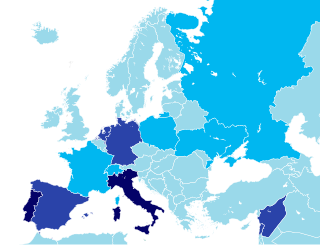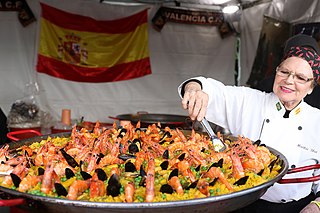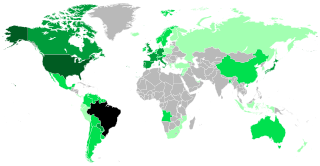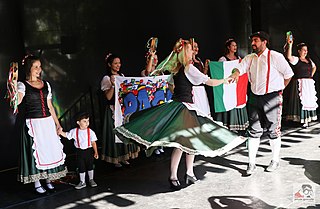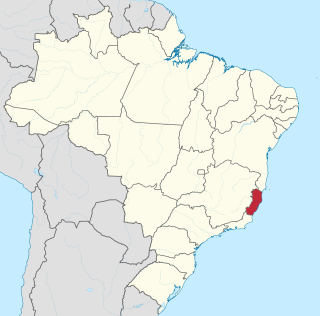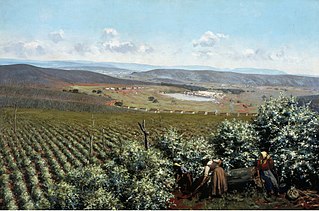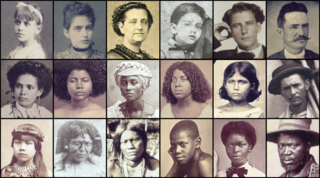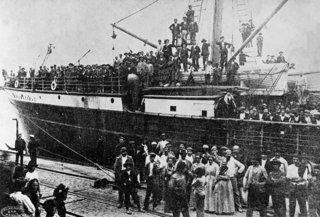History
Maria Stella Ferreira Levy [2] suggests the following periodisation of the process of immigration to Brazil:
- 1. 1820-1876: small number of immigrants (about 6,000 per year), predominance of Portuguese (45.73%), with significant numbers of Germans (12.97%);
- 2. 1877-1903: large number of immigrants (about 71,000 per year), predominance of Italians (58.49%);
- 3. 1904-1930: large number of immigrants (about 79,000 per year), predominance of the Portuguese (36.97%);
- 4. 1931-1963: declining number of immigrants (about 33,500 per year), predominance of the Portuguese (38.45%).
During the first two periods, immigration to Brazil was almost exclusively of European origin, and it remained the majority during all four, in spite of the increasing importance of Japanese immigration.
First period: 1820-1872
Immigration properly started with the opening of the Brazilian ports, in 1808. The government began to stimulate the arrival of Europeans to occupy plots of land and become small farmers. After independence from Portugal, the Brazilian Empire focused on the occupation of the provinces of Southern Brazil. [3] From 1824, immigrants from Central Europe started to populate what is nowadays the region of São Leopoldo, in the province of Rio Grande do Sul. Immigration stalled in 1830, due to legislation forbidding government spending with the settlement of immigrants. Besides, Rio Grande do Sul, the main target of immigration, was convulsed with civil war from 1835 to 1845. [4]
Between 1820 and 1871, 350,117 immigrants entered Brazil. Of these, 45.73% were Portuguese, 35.74% of "other nationalities," 12.97% Germans, while Italians and Spanish together did not reach 6%. The total number of immigrants per year averaged 6,000. [5] Portuguese immigrants generally were sought after for the cities as they were established in commerce and peddling; others, particularly the Germans, were brought to settle in rural communities as small landowners. They received land, seed, livestock and other items to develop.


Second Period: 1872-1903
In the last quarter of the 19th century, the entry of immigrants in Brazil grew strongly. On one hand, Europe underwent a serious demographic crisis, which resulted in increased immigration; on the other hand, the final crisis of Brazilian slavery prompted Brazilian authorities to find solutions for the problem of work force. Consequently, while immigration until 1872 was focused on establishing communities of landowners, during this period, while this older process continued, immigrants were more and more attracted to the coffee plantations of São Paulo, where they became employees or were allowed to cultivate small tracts of land in exchange for their work in the coffee crop. [3]
During this period, immigration was much more intense: large numbers of Europeans, especially Italians, 1.1 million (of a total of almost 2 million from 1870 to 1940), were brought to the country to work in the harvest of coffee, their travel being paid by Brazilian government. [6] 1872 to 1903, almost two million immigrants arrived, at a rate of 71,000 per year [7]

By the beginning of the 1870s, the alternative of the interprovincial slave trade was exhausted, while the demand for workforce in the coffee plantations continued to expand. Thus the paulista oligarchy sought to attract new workers from abroad, by passing provincial legislation and pressuring the Brazilian government to organise immigration. [8] [9] Tensions arose between the governmental bureaucracy, that was concerned in populating the country with immigrants deemed easily adaptable to Brazilian culture and compatible with the racial prejudices of the time, and the coffee planters, eager for cheap labour force of whatever origin; government concerns predominated while Italian and Spanish immigration was sufficient to meet the demand, but as early as 1892 pressure from the planters forced the government to abandon restrictions against Asian immigrants, although a serious crisis in the coffee culture by the end of the century postponed any practical initiatives concerning this until 1908.
Third period: 1904-1930
From 1904 to 1930, 2,142,781 immigrants came to Brazil - making an annual average of 79,000 people. In consequence of the Prinetti Decree of 1902, that forbade subsidised emigration to Brazil, Italian immigration had, at this stage, a drastic reduction: their average annual entries from 1887 to 1903 was 58,000. In this period they were only 19,000 annually. As a consequence, immigration of non-Europeans was organised, with Japanese immigrants arriving from 1908 on. The Portuguese constituted 38% of entries, followed by Spaniards with 22% and Germans. From 1914 to 1918, due to World War I, the entry of immigrants of all nationalities decreased. [5] After the War, the immigration of people of "other nationalities" redressed faster than that of Portuguese, Spaniards, Germans and Italians. Part of this category was composed of immigrants from Poland, Russia and Romania - whose emigration was prompted by the collapse of the Russian and Austrian-Hungarian Empires in the aftermath of the First World War - but part by non-Europeans, mainly Syrian and Lebanese people. Both subgroups included a number of Jewish immigrants, who arrived in the 1920s. Overall, European immigration remained clearly majoritary during the period, though Japanese immigration grew, and attempts to restrict immigration to Europeans, on racist bases, in 1921 and 1923, were defeated in the Brazilian Congress; however, attempts to organise Black American immigration to Brazil also failed due to administrative action by the Brazilian consulates in the United States, that systematically denied visa to Black applicants, on confidential orders by the Brazilian Foreign Affairs Ministry. [10]
Fourth Period: 1931-1964
From 1931 to 1963, 1,106,404 immigrants entered Brazil, at an annual rate of 33,500. The participation of Europeans decreased, while that of Japanese increased. From 1932 to 1935 immigrants from Japan constituted 30% of total admissions. [5]
With the radicalisation of the political situation in Europe, the end of the demographic crisis, the decadence of coffee culture, the Revolution of 1930 and the consequent rise of a nationalist government, immigration to Brazil was significantly reduced. The Portuguese remained the most significant group, with 39.35%. [5]
Immigration also became a more urban phenomenon; most immigrants came for the cities, and even the descendants of the immigrants of the previous periods were moving intensely from the countryside. In the 1950s, Brazil started a program of immigration to provide workers for Brazilian industries. In São Paulo, for example, between 1957 and 1961, more than 30% of the Spanish, over 50% of the Italian and 70% of the Greek immigrants were brought to work in factories.




